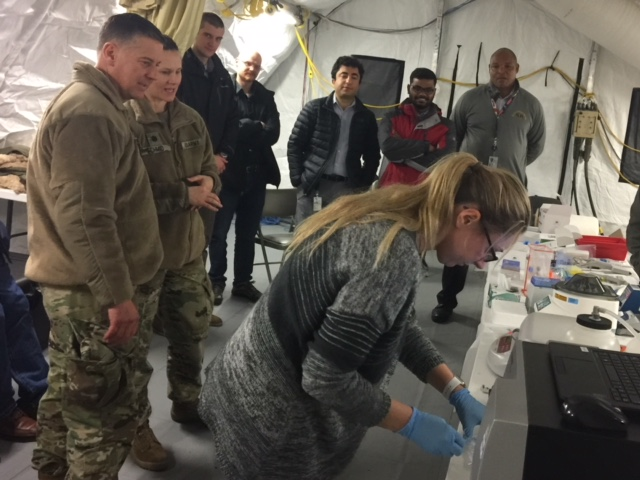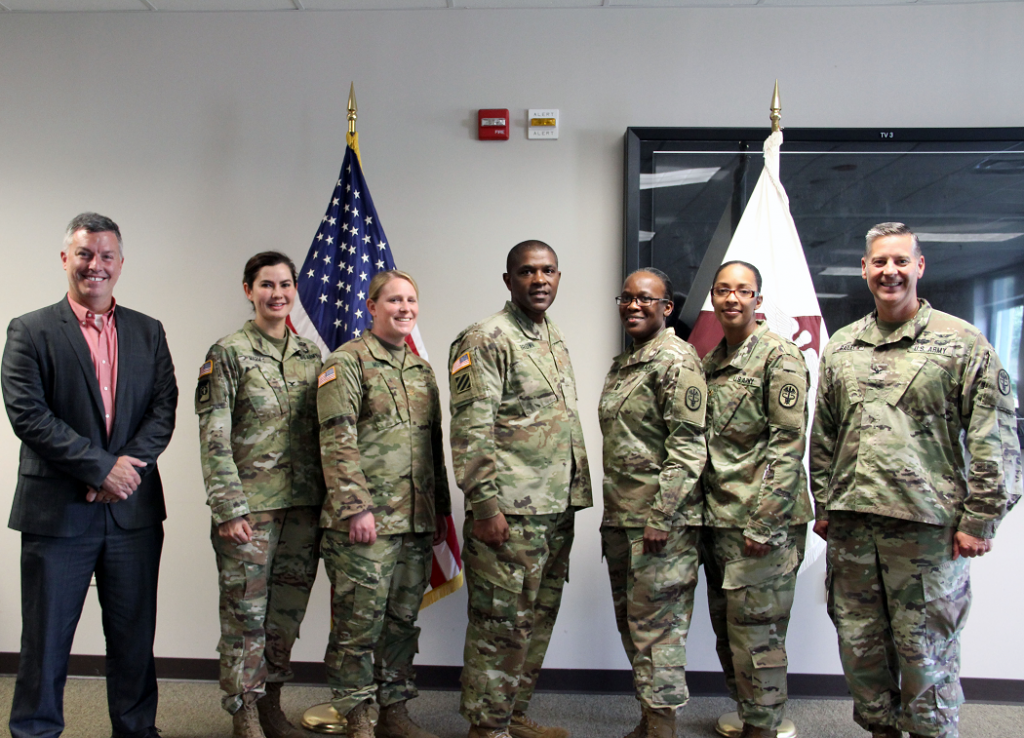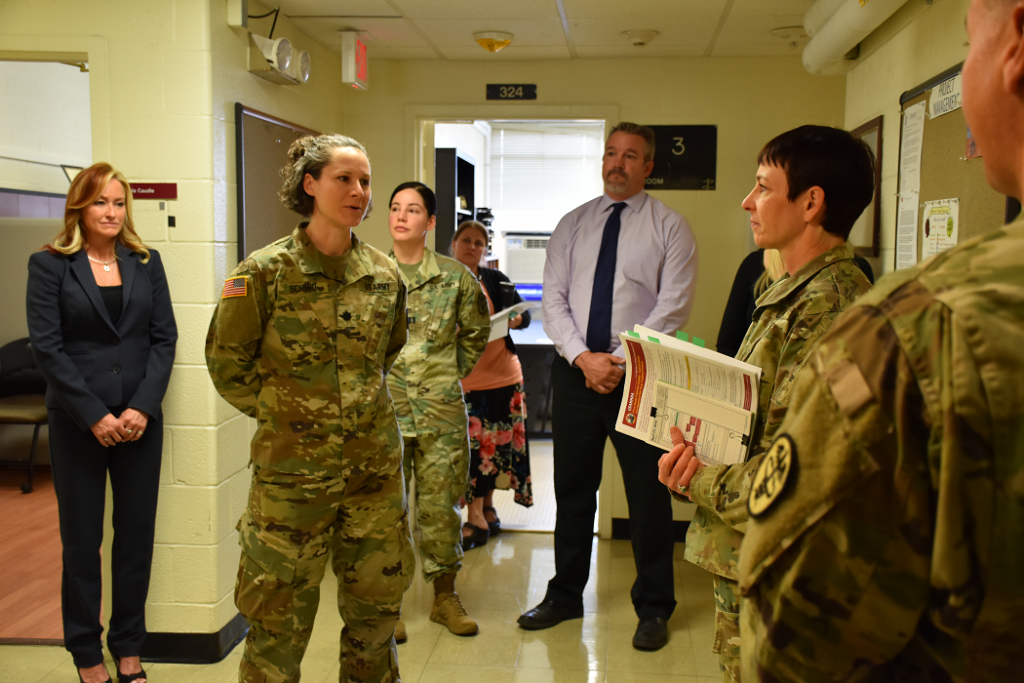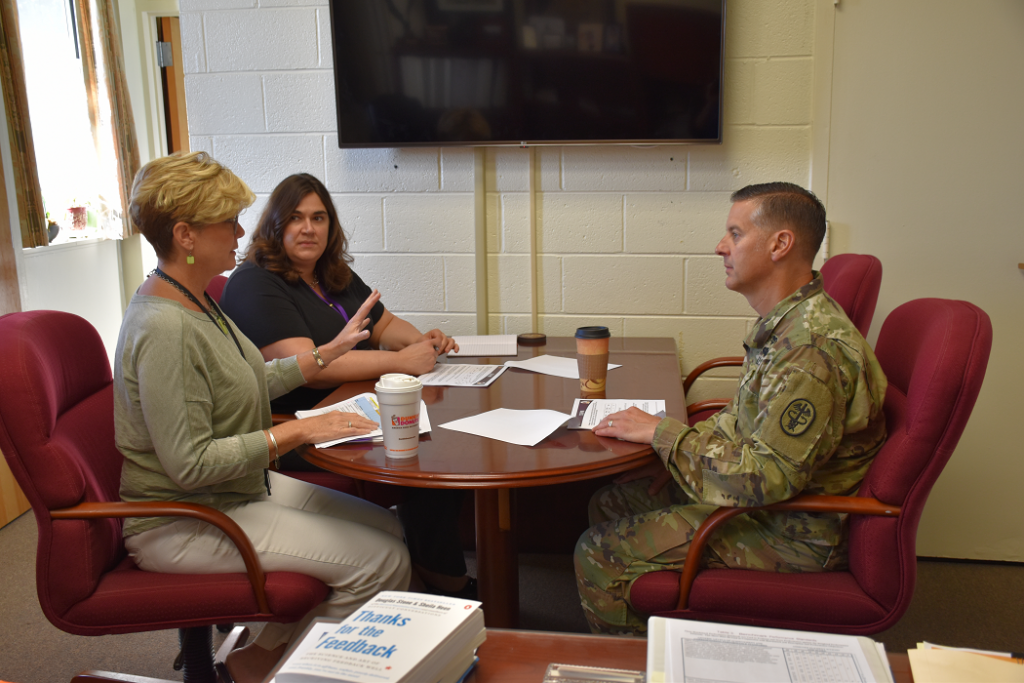
USAMMDA develops a reputation for growing acquisition workforce leaders.
by Mr. Jeffrey M. Soares
The U.S. Army Medical Materiel Development Activity (USAMMDA) at Fort Detrick, Maryland, is helping to prepare future leaders of the acquisition workforce. USAMMDA cultivates a cadre of acquisition professionals, both military and civilian, who go on to leadership roles in other areas of the Army and DOD. In fact, over the last few years, six former and current members of the USAMMDA team have been chosen from the Army Acquisition Centralized Selection List to serve as leaders in other acquisition commands throughout the country.
“The breadth and depth of our command offer distinct exposure to a wide range of medical materiel solutions,” said Col. Ryan Bailey, USAMMDA commander. “From a military perspective, an assignment at USAMMDA offers an opportunity to be part of an organization that is focused on true acquisition medical product development, beginning at the analysis of alternatives, through the entire life cycle process.
“Understanding the acquisition component—the acquisition and sustainment strategy—while also working with stakeholders and users to understand the particular requirement provides true on-the-job, hands-on experience,” Bailey said. “It’s invaluable.”

The 2018 graduating class of the joint Program Management–Acquisitions Internship Program of the USAMMDA and the U.S. Army Medical Materiel Agency, Fort Detrick, Maryland. From left to right: Dr. Tyler Bennett, deputy to the commander for acquisition, USAMMA Col. Lynn Marm, USAMMA commander Maj. Janessa R. Moyer Maj. Jeffrey L. Brown Capt. Efther V. Samuel Maj. Amber L. Smith and Col. Ryan Bailey, USAMMDA commander. Capt. Amanda L. Roth was not present for photo. (Photo by Gregory Pugh, USAMMA public affairs)
AN ENVIRONMENT UNLIKE OTHERS
As Bailey suggested, a position at USAMMDA provides a unique acquisition experience, primarily because of the organization’s role as a medical product developer. While the Army acquisition system evolved to procure items such as tanks, planes, weapons and other defense equipment, USAMMDA tailors this process to advance military medical products, devices, pharmaceuticals, vaccines and other medical solutions for warfighters. The organization is the Army’s lead resource for the advanced development, licensure and fielding of pharmaceutical products for use by the U.S. military.
Because of that focus, product and project managers at USAMMDA gain in-depth knowledge in regulatory affairs as they work with the U.S. Food and Drug Administration (FDA) to ensure the safety and efficacy of all pertinent products managed by the command, offering staff members a unique experience within Army medicine.
In this year alone, the command can claim three Army officers chosen to fill leadership roles via the Centralized Selection List process: Lt. Col. Charles Ditusa, Lt. Col. Bryan Gnade and Lt. Col. Kara Schmid. Schmid currently serves USAMMDA as project manager of the Neurotrauma and Psychological Health Project Management Office. Beginning in FY 2019, she will assume the role of joint product manager for Chemical Defense Pharmaceuticals within the Medical Countermeasures Systems Joint Project Management Office at Fort Detrick.
Ditusa recently departed USAMMDA to serve as acting assistant product manager of the Biodefense Therapeutics Antiviral Program under the Joint Program Executive Office for Chemical, Biological, Radiological and Nuclear Defense. Gnade, currently chief of the Diagnostics Systems Division of the U.S. Army Medical Research Institute of Infectious Diseases, was selected to serve as a product manager in the Program Executive Office for Simulation, Training and Instrumentation.
With two Centralized Selection List positions on his own resume, Bailey knows what the committee looks for when evaluating applications. Candidates for acquisition positions should have the pertinent acquisition certifications coupled with related experience, and they should also have successful leadership experience—all of which are available and highly encouraged during an assignment at USAMMDA.
“I would say that my selection for this particular position was based on my experience as a product manager, and then as a project manager, at USAMMDA as a lieutenant colonel,” said Schmid. “These two positions relate closely to what I will be doing as the joint product manager for the Chemical Defense Pharmaceuticals office.”
Over the past 12 years, Schmid considers herself fortunate to have remained involved with the Laboratory Assay for Traumatic Brain Injury (LATBI) acquisition program, which has been a prime focus of Army medicine during the last decade. In 2015, Schmid joined USAMMDA as product manager for Traumatic Brain Injury before being named project manager for Neurotrauma and Psychological Health, overseeing the LATBI program.
Schmid noted that her time at USAMMDA helped to prepare her for her upcoming role. “The entire work of USAMMDA is centered on acquisition,” said Schmid. “Being a product manager here gives you day-to-day acquisition experience in product development—you are directly responsible for the cost, schedule and performance of your program. But I also gained experience as a project manager, where you’re in charge of the oversight and strategic vision of the entire program, much like the joint product manager role that I will be taking on.
“As a project manager at USAMMDA, you’re offered valuable experience in making decisions on a program-wide level,” she said. “Everything you learn on the job, and from other USAMMDA leadership, helps you to understand how to prioritize funding, as well as people and their time, based on the products being developed by the team.”

Lt. Col. Kara Schmid (center), project manager of USAMMDAs Neurotrauma and Psychological Health Project Management Office, briefs Maj. Gen. Barbara R. Holcomb, USAMRMC and Fort Detrick commander, on the NPH PMO’s products and accomplishments during Holcomb’s tour of USAMMDA. (Photo by Ashley Force, USAMMDA public affairs)
LEVERAGING THE USAMMDA EXPERIENCE
Another unique aspect of an assignment at USAMMDA is that the command has medical acquisition-coded billets that allow officers to attend training through Defense Acquisition University (DAU)—a certification that remains critical for career advancement in Army acquisition and membership in the Army Acquisition Corps. Corps membership is mandatory for all Army acquisition, logistics and technology workforce members who hold key leadership positions. While essential requirements for DAU are satisfied through product manager and assistant product manager positions at USAMMDA, Bailey noted that DAU provides the textbook acquisition training while USAMMDA offers the on-the-job experience that links the process together.
Further, these candidates also gain the required experience in working to transition a product from multiple science and technology partners in the U.S. Army Medical Research and Materiel Command (USAMRMC), moving through the product life cycle to fielding, sustainment and modernization. Additionally, they work with contracting agencies to partner with the necessary commercial entities to complete the advanced development of these products. In doing so, they gain valuable knowledge in working within contracting guidelines such as cooperative research and development agreements and other transaction authorities.
Col. Jeanne Norwood currently serves as the joint product manager for the Joint Vaccine Acquisition Program within the Medical Countermeasures Systems Joint Project Management Office, and much like Schmid, her path to this position includes successful work in product development and acquisition at USAMMDA.
As a product manager within the Pharmaceutical Systems Program Management Office, Norwood, then a lieutenant colonel, led critical efforts to develop diagnostics and therapeutics to treat cutaneous leishmaniasis, a skin infection caused by a single-celled parasite that is transmitted by an insect bite. Along with these duties, she served as chair of an integrated product team that was responsible for the development of medical products to protect warfighters from infectious disease threats.
“During my tenure at USAMMDA,” Norwood explained, “I was involved in all phases of the product development process, from supporting early science and technology efforts, to executing Phase III clinical trials, to getting a critical product cleared by the FDA and transitioning it to the U.S. Army Medical Materiel Agency for fielding.”
Echoing Schmid, Norwood agreed that the work and training provided at USAMMDA allowed her to grow in the acquisition and advanced development fields. “My experience at USAMMDA helped me to understand and appreciate the importance of functional teams,” said Norwood. “Although some of my learning may have been trial by fire, because I was new to advanced development at that time, USAMMDA leadership empowered me to lead my team to advance critical products to the warfighter, and that was really encouraging.”
She added that her assignment at USAMMDA “provided my first chance to see a product cross the finish line and go into the hands of the people that really need it. Once you’re part of a success such as that, you want to see it happen again.”

USAMMDA commander Col. Ryan Bailey (right) meets with Kathleen Berst, USAMMDA deputy for acquisition (center), and Christine Parker, acting project manager for USAMMDAs Medical Devices–Advanced Development Project Management Office. (Photo by Ashley Force, USAMMDA public affairs)
CONCLUSION
USAMMDA has seen its share of success over the years. From critical vaccines and blood products that help to save lives on and off the battlefield, to medical products, devices and treatments that help restore wounded warfighters returning from battle, USAMMDA’s status as a solid training environment to help prepare future leaders is secure.
“USAMMDA truly is a great organization that helps to build the bench of acquisition leaders,” said Bailey. “People who join our team obtain the education and experience to develop as professionals in the field, and then rotate out to lead in other diverse acquisition environments.”
Schmid and others on the USAMMDA team believe that USAMMDA is one of the most diverse commands under the U.S. Army Medical Command, which supports its status as an effective training environment.
As the USAMRMC is a life cycle management command, USAMMDA has the entire product development mission under one roof. From infectious diseases to operational medicine, and combat casualty care to rehabilitation, the organization is responsible for developing solutions for everything from basic training to return from battle, which also includes non-battle injuries and diseases.
“Our greatest challenge may actually be the breadth of the work we do here at USAMMDA and throughout the USAMRMC,” said Schmid, “but we have all learned to become very efficient at our jobs, and this is something that I truly value from my experience within the command.”
Despite her years of experience and training, or perhaps because of them, Schmid realizes she must continue to develop and grow with each new assignment—including the one fast approaching. “I’m starting to brush up on my knowledge of chemical and biological threats, in between my current responsibilities,” she explained. “In my new position, I almost feel like I’ll be a freshman again. There will be a lot to learn, but I know there’s a very strong team already in place, which will help make the transition much easier.”
For more information on the work and mission of USAMMDA, go to http://www.usammda.army.mil/.
JEFFREY M. SOARES is a senior technical writer and communications specialist with General Dynamics Information Technology, providing contract support as chief writer for the Public Affairs Office and Office of the Commander at USAMMDA. He holds an M.A. in English language and literature from the University of Maryland, College Park, and a B.S. in education with a concentration in English from the University of Scranton.
ADDED RESPONSIBILITIES
The breadth of work at USAMMDA will soon increase as the organization absorbed 27 product development personnel from the U.S. Army Medical Materiel Agency (USAMMA) in July. The transition will add many new medical products to USAMMDA’s portfolio, which Bailey noted will “help to create even more opportunities for product knowledge and acquisition skill development, and build a much stronger USAMMDA workforce.”
With the influx of additional personnel, the need for specialized training will increase as well. Bailey explained that while at USAMMDA, Soldiers may also satisfy their requirements for the Army’s 8X Additional Skill Identifier, which remains on their permanent records to show they have successfully completed additional acquisition skills training for an Army Medical Department acquisition officer. Further, both USAMMDA and USAMMA offer the Program Management – Acquisitions Internship Program, which is designed to recruit junior officers to the field earlier in their careers to begin developing acquisition skills for future positions within the workforce.
Schmid praised the internship program as an effective way of creating a large pool of well-trained officers who could one day fill critical acquisition gaps throughout the Army. “Gaining experience in acquisition while you’re still a captain will really help you to understand how the USAMRMC does business,” she said. “Also, having experiences like this early in your career as an officer will certainly help to prepare you for leadership roles later on.”
This article will be published in the October – December 2018 issue of Army AL&T magazine.
Subscribe to Army AL&T News, the premier online news source for the Acquisition, Logistics, and Technology (AL&T) Workforce.







